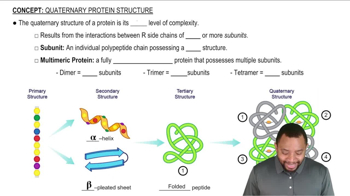Answer the following questions for the given section of DNA:
c. Write the three-letter symbols for the amino acids that would go into the peptide from the mRNA you wrote in part b.
 Verified step by step guidance
Verified step by step guidance Verified video answer for a similar problem:
Verified video answer for a similar problem:


 2:42m
2:42mMaster Translation: Protein Synthesis Concept 1 with a bite sized video explanation from Jules
Start learning